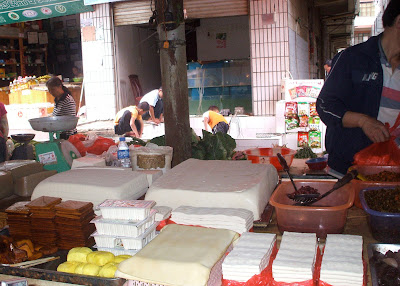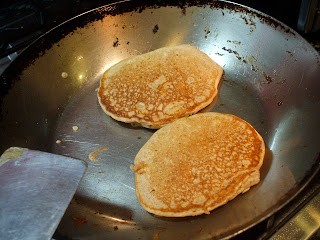 |
| (I was gonna take a shot of the whole thing...but pie doesn't last long here) |
It finally happened. I'd been planning on baking a pie since I stepped off the plane from China months ago. An apple pie, of course, as that is the best kind. However, I didn't make an apple pie right away. I didn't make an apple pie for months and months, because it wasn't apple season. But now it is apple season! The apples are beautiful and copious and among the cheaper fruits to buy.

I didn't buy the apples for this pie. My Dad did. You see, he really likes apple pie. About once a day for a week or so, he talked about how he wanted an apple pie. Then he went to the store and bought apples... lots of apples. I took care of the rest.
There was a wonderful moment with my Mom as well. Most of the time, when I want to bake something, my mother begs me to use a recipe and I gripe about it and try to improv my way to a layer cake/loaf of bread/chocolate chip cookie. However, as I had not made an apple pie for some time, I thought it best to consult a recipe. Naturally, I asked my Mom which one I ought to use. And, get this, folks... she doesn't use one! Which gave me a perfect excuse not to either, although I did consult a few along the way.
The results: buttery, appley, cinnamony goodness...gone in 24 hours.
Ingredients (Crust)
 -3 cups flour (I used 2 cups all purpose and 1 cup whole wheat)
-3 cups flour (I used 2 cups all purpose and 1 cup whole wheat)-1 tsp salt (or to taste)
-1 tsp ground cinnamon
-1 TBS sugar
-10 TBS butter, cold and chopped into small pieces
-3 TBS cold water
Procedure
-Mix the dry ingredients thoroughly, then cut in the butter by hand with two knives, with a pastry cutter, or in a food processor. When you're done, the butter should be in no-larger-than-pea-sized lumps. Add water as necessary. When you think the crust is just a little too dry, stop adding water and just mix patiently until it comes together. Sometimes mushing it together by hand helps.
 -Divide the crust in half and roll out one half to a thin layer a bit big for your pie dish. Gently lift it into the dish, pat into place, and trim the edges so that they're just draping over the sides. (You should probably use scissors or a knife or something to do this, but I've never bothered. That's what hands are for.)
-Divide the crust in half and roll out one half to a thin layer a bit big for your pie dish. Gently lift it into the dish, pat into place, and trim the edges so that they're just draping over the sides. (You should probably use scissors or a knife or something to do this, but I've never bothered. That's what hands are for.)-Place filling (see below) in the crust and top, gently, with the other rolled-out half. Same deal with trimming, making sure you leave enough to pinch the edges of the two crusts together. I had enough crust left over to roll a thin snake to lay out on top of the border, so you can feel free to do the same, or just use it all for lambs' tails (more on that in a minute)
-Poke some holes in the top with a fork, or if you want to be fancy make some small cuts with a sharp knife.
Ingredients (Filling)
 -About 6 medium apples (I used some honeycrisp and some granny smith) cored, peeled if you like (I usually peel about half), and sliced thinly.
-About 6 medium apples (I used some honeycrisp and some granny smith) cored, peeled if you like (I usually peel about half), and sliced thinly.-2 TBS lemon juice
-2 TBS flour
-sugar and brown sugar-- this is where subjectivity really comes into play. I like a less sweet and more appley apple pie, so I use less sugar than many would, but I still throw in more than some folks. I'd say I put in about 1/4 cup white sugar and 1/2 cup brown sugar. Just keep tasting until it's sweet enough for you. I honestly didn't measure.
-1/2 tsp. salt
-1.5 tsp. cinnamon
-1/4-1/2 tsp nutmeg and cloves (to taste)
-1 TBS corn starch
Procedure: Mix it all together, gently but thoroughly. Doesn't get much simpler than that. Place atop the bottom crust. If it looks like too little filling, you can add another sliced apple.
Baking: Top your pie with cinnamon sugar, if you like, and bake at 425°F for about 25 minutes, then turn down to 350°F and cook for 30-45 minutes more, until the filling is nice and bubbly and the crust is golden. If the top starts getting too brown, you can cover it loosely with aluminum foil.
The biggest problem with apple pie is that it has to cool for, like, hours. Many hours. Luckily, lambs' tails don't, and they're a cinch to make. Just take your leftover crust, roll it out, top with brown sugar or cinnamon sugar, roll up carpet-style, and cut into pieces a few inches long. Place in the oven alongside your pie and bake for 10-15 minutes, until puffy and golden. Cool for about 10 minutes, and munch. Bide your time until you can get this:
Oh... and I know I didn't use any macintoshes, but this one's for Steve, creator of each and every computer my family's ever owned (yes, including the MacBook I'm typing on). We miss you.















































